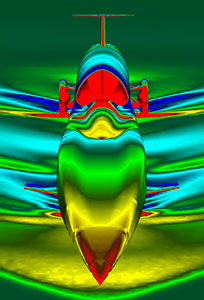 With more than half a billion television viewers across the globe and annual revenues of around $4 billion (£2.5 billion), Formula One is among the most popular sports in the world. It is a highly competitive field where even a fraction of a second can mean the difference between first or second place, so Formula One teams will do whatever it takes to gain an advantage. In the past ten years, that’s increasingly meant relying on performance boosts through advanced mathematics.
With more than half a billion television viewers across the globe and annual revenues of around $4 billion (£2.5 billion), Formula One is among the most popular sports in the world. It is a highly competitive field where even a fraction of a second can mean the difference between first or second place, so Formula One teams will do whatever it takes to gain an advantage. In the past ten years, that’s increasingly meant relying on performance boosts through advanced mathematics.
The design of Formula One cars has constantly evolved throughout the sport’s history, as teams attempt to both out-smart their competitors and keep up with ever- changing regulations. Since aerodynamic performance is one of the most important factors in a car’s design, teams now use fluid dynamics, the mathematical study of moving liquids and gases, to model the flow of air past the car as it races to the finish line. Fundamental to this study are the Navier- Stokes equations, which are so complex that they cannot be solved directly. Instead, mathematicians turn to powerful computers to provide approximate but accurate solutions.
This method, known as computational fluid dynamics (CFD), involves creating a detailed digital 3D model of the object in question, which could be an individual part such as the wings or even the whole car. Both the model surface and the space around it are then split into smaller “cells”, some no larger than a quarter of a millimetre, and fed into a computer that solves the Navier-Stokes equations in each cell to produce a simulation of the air flow around the whole object.
The process requires an incredible amount of computing power, but current Formula One regulations limit the number of computers that teams can use in designing the car, in an effort to keep the sport fair. While buying faster computers will always lead to better CFD models, Mark Taylor, Head of CFD at McLaren Racing, prefers to work smarter. Since all teams have access to similar levels of computing, the only deciding factor in CFD performance is the quality of the mathematics that they use. McLaren invests heavily in mathematics as a means to beat its competitors, but the work it carries out is reliant on the latest research coming out of universities.
While much of the modelling done at McLaren uses off-the-shelf CFD software, the real race-winning performance gains are made through custom solutions developed in partnership with academic researchers. The fast-paced nature of Formula One leaves little time for fundamental research, so McLaren works with UK universities on long term problems that may not yield performance boosts in the short-term. These projects can take up to five years, but once completed Taylor and his team can bring the research in-house and adapt it to McLaren’s needs.
This integration of the latest CFD research has transformed the way Formula One design teams work. A decade ago, engineers would test their parts using just a wind tunnel, a process requiring a large amount of patience and experience. Every small modification would require the creation of a new part, costing both time and money. Now, Formula One teams can use CFD to rapidly try out new ideas without having to physically build new parts and test them in the tunnel, allowing them to get innovative car components on to the track much quicker than ever before.
 The rise of CFD seems unstoppable, with McLaren using mathematics to improve its aerodynamic performance in each of the past five years while at the same time reducing its reliance on wind tunnels. The CFD research carried out by McLaren also trickles down to its high-end consumer cars. Their latest supercar, the MP4-12C, was designed using knowledge gained from experience in designing Formula One cars – knowledge which in turn stems from fundamental research at UK universities. Other consumer car manufacturers also use CFD to streamline their designs, reducing drag and ensuring greater fuel efficiency.
The rise of CFD seems unstoppable, with McLaren using mathematics to improve its aerodynamic performance in each of the past five years while at the same time reducing its reliance on wind tunnels. The CFD research carried out by McLaren also trickles down to its high-end consumer cars. Their latest supercar, the MP4-12C, was designed using knowledge gained from experience in designing Formula One cars – knowledge which in turn stems from fundamental research at UK universities. Other consumer car manufacturers also use CFD to streamline their designs, reducing drag and ensuring greater fuel efficiency.
This three-tier model of knowledge transfer makes university research essential to the success of McLaren and other Formula One businesses, and university mathematics departments also provide teams like McLaren with the people that they need to win races. Taylor prefers to hire people with PhDs that both demonstrate a high-quality understanding of the mathematics involved in CFD, and extensive experience with scientific research and problem solving.
Although CFD research and the people who conduct it can also be found elsewhere, Taylor believes that the academic community in the UK have a unique understanding and capability for supporting the Formula One industry. Close ties between universities and racing teams have led to great success on the track so far, but Taylor worries that it would be difficult for them to remain competitive if McLaren were forced to look for expertise abroad. Support for home-grown mathematicians means the supply of top-quality research will continue, ensuring that British teams like McLaren stay part of the Formula One success story.
Technical Supplement
Navier-Stokes equations
The Navier-Stokes equations were first derived by the French physicist Claude-Louis Navier in 1822, but later developed independently by the Cambridge mathematician George Stokes in 1845, who wrote the equations in the form still used today. The equations are derived from Newton’s second law of motion, force equals mass times acceleration, and describe the relationship between the velocity, pressure, viscosity and density of a moving fluid.
As a linked set of four nonlinear partial differential equations the Navier-Stokes equations are impossible to solve analytically in all but a few very simple cases, hence the need for the numerical approximation methods employed in CFD. These methods allow us to apply the Navier-Stokes equations to a range of practical situations, but mathematicians aren’t yet able to fully explain how the equations work, particularly in the case of turbulent flows. The problem is considered so important that the Clay Mathematics Institute has offered a $1 million prize for a proof that furthers our understanding.
CFD methods
Dividing a 3D model into the millions of cells required for CFD is a complex task, but one that has become easier over the years thanks to new mathematics. In the 1980s it could take up to six months for a particularly complex configuration, but modern methods can generate these collections of cell, known as a mesh, in less than 24 hours.
An accurate mesh is an essential part of a CFD simulation, as any missing or overlapping cells can lead to errors in the result, so mathematicians such as Kenneth Morgan at Swansea University are always working to improve them. Morgan has previously developed algorithms that can automatically generate a 3D mesh composed of tetrahedra from a 2D surface mesh made up of triangles, reducing the time required to create the full mesh, and he continues to explore new and enhanced methods. He is also currently using CFD to help design BLOODHOUND SSC, a car that aims to reach 1,000 miles-per-hour and capture the Land Speed Record.
References
Hassan, O., Morgan, K., Probert, E. J., and Peraire, J. (1996) Unstructured tetrahedral mesh generation for three-dimensional viscous flows. International Journal for Numerical Methods in Engineering. 39(4), 549-567. DOI: 10.1002/ (SICI)1097-0207(19960229)39:4<549::AID- NME868>3.0.CO;2-O
Morgan, K., Hassan, O. & Weatherill, N. P. (1999) Why didn’t the supersonic car fly? Mathematics Today, 35, 110-113.
EPSRC Grants
Reference: EP/D074258/1
Title: Advances in Mesh Generation
The IMA would like to thank Dr. Mark Taylor, McLaren Racing and Professor Kenneth Morgan, Swansea University for their help in the preparation of this document.
Image Credit
A High Shutter Time Shot of a Highway by Steve Freling of Motor Oomph
Printable Version
Download a printable version of this paper here:



